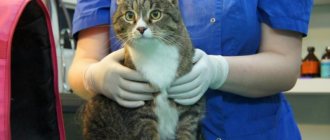Amphibians are in high demand. They are often bred at home for breeding, given to children, or simply bred as a hobby so that there is someone to take care of. Despite the fact that turtles are unpretentious animals and do not require special care, it is still necessary to closely monitor their health. Turtles are especially susceptible to eye diseases. Often, pathogenic bacteria penetrate into them, which can cause severe infections, inflammation and other unpleasant symptoms.
Uveitis and panophthalmitis
These conditions are characterized by inflammatory processes that can involve various tissues of the eye.
With uveitis, the disease affects the anterior chamber of the uveal tract, and with panophthalmitis, it affects all the membranes of the optic organ. Disturbances develop as a complication of septic pneumonia or as a result of sudden hypothermia. It can also be caused by pathogenic bacteria that have penetrated from the oral cavity into the subcorneal space through the lacrimal canal. With uveitis, the eye remains intact, but pus accumulates under the eyelids. As a rule, inflammation develops bilaterally. In addition, the condition may be accompanied by loss of appetite, exhaustion, rhinitis and lethargy.
Photo: vet.ru
Panophthalmitis manifests itself as a sharp swelling of the eyelids and thickening of the tissues of the visual organ. The turtle's eye becomes like a dense granule filled with pus, with cloudiness in the center.
Treatment of these diseases is carried out surgically, and eye rinsing and antibiotics are also indicated. The selection of drugs and treatment regimen are determined on an individual basis.
Burns
I degree. Redness and peeling of the epithelium is observed.
II degree. Blisters appear and fluid accumulates under the stratum corneum.
1) IIIa – skin necrosis without damage to the basal layer;
2) IIIb – necrosis of the skin with damage to the basal layer.
First degree burns require virtually no treatment. For burns of second degree or more, the burn surface is treated with a cloth soaked in a 70% solution of ethyl alcohol, removing dead tissue.
The bubbles are opened, their upper part is carefully cut off. Then the wounds are successively covered with a 5% aqueous solution of tannin and a 10% solution of silver nitrate. As a result of these manipulations, a crust forms on the surface of the wound, which eventually comes off on its own.
Symptomatic treatment
If after 6 hours the eyes have not opened, then the pet is sick. In this case, it is necessary to wash the turtle in warm running water and place it in another container, and thoroughly disinfect the aquaterrarium and add a few drops of a diluted solution of methylene blue to it.
Eye drops will help relieve symptoms (they are instilled under the eyelid twice a day): Albucid (another name is sodium sulfacyl), Sofradex, Tobradex, Tsiprovet, Floxal, Eleovit. You can also use tetracycline ointment. If your turtle is rubbing its eyes, you will need hydrocortisone ointment. Before using eye drops, it is necessary to remove plaque by wiping the eyes with a chamomile decoction or a 3% solution of boric acid. In case of suppuration or cheesy nitrates, wash the eyes with Ringer's saline solution. After the procedure, the animal is left on dry land for 30-40 minutes.
A chamomile bath will also benefit the animal. To prepare it, pour 100 grams of chamomile flowers with 2-3 liters of boiling water. Infuse the decoction for 15-20 minutes and pour it into a container with warm water. Leave the turtle in the medicinal bath until it cools down. Then the pet is warmed up well for 6 hours under an ultraviolet lamp.
But the above methods are only used as temporary measures to help your pet open his eyes. To find out the cause of the pathology and eliminate it, you need to contact a veterinarian. In most cases, antibacterial drugs will be required, which only a specialist can select.
Features of conjunctivitis
If the turtle's eyes do not open, this may indicate the presence of conjunctivitis.
At the initial stage, inflammation of only one visual organ is observed, but if this disease is started, the inflammatory process can spread to both eyes. In addition, when the disease starts, the mucous membrane of the eye becomes dark red. Often this disease occurs due to dirty water. For this reason, it needs to be cleaned regularly. But you shouldn’t rely on a filter, because this device cannot clean it of all contaminants.
Features of therapeutic therapy:
- first of all, the amphibian animal should be placed in a separate clean and dry container;
- It is imperative to completely disinfect the aquaterrarium;
- the turtle must be washed in warm water;
- after bathing your pet, you need to thoroughly, but very carefully wipe it with a paper towel;
- In the morning, at lunchtime and in the evening, it is recommended to instill sodium sulfacyl (also called albucid) into the eyes;
- If the damage is severe, it may be necessary to apply tetracycline ointment to the eyes.
The swelling will subside on the same day, in the evening. And your eyes will open the next morning. But with severe inflammation, treatment may take relatively longer.
Note! Before placing the reptile in the aquarium, it is recommended to add a couple of drops of methylene blue to the water, but this product must first be diluted with a small amount of water.
How to treat the eyes of red-eared turtles?
What to do if your red-eared slider's eyes are swollen? This question interests many breeders who care about the life of their beloved pet. Treatment of turtles if their eyes, eyelids are swollen, or any other ophthalmological ailment is diagnosed, is prescribed by a veterinarian.
It is very important to establish what caused the eye disease in your pet, normalize its general condition, restore visual acuity and visual function if it is impaired.
Important! As a rule, therapeutic therapy involves complex treatment using general medications and drugs for local treatment (drops, ointments, liniments). If your turtle's eyes are swollen and cannot open, or the eyelids are inflamed due to conjunctivitis, first of all it is necessary to establish the root cause
Be sure to move your pet to a new aquarium and create optimal living conditions. Change the water in the turtle's usual habitat.
If a turtle's eyes are swollen and cannot open, or the eyelids are inflamed due to conjunctivitis, the root cause must first be determined. Be sure to move your pet to a new aquarium and create optimal living conditions. Change the water in the turtle's usual habitat.
Antibacterial drops, anti-inflammatory, and general restoratives are used in treatment. The following medications can be prescribed to your pet: Albucid, Sofradex, Tsiprolet, Tsiprovet, Floxal. Drops are applied to the eyes 2–3 times a day for 5–7 days.
If your tortoise cannot open its eyes on its own, gently pull down your pet's lower eyelid before adding drops. Before carrying out the procedure, use a sterile gauze-cotton swab to wipe the eyes from dirt, remove dry crusts using physiological solutions, antiseptics (Ringer-Locke solution).
Important! Drops should be instilled into each eye, even if the eyelids are swollen and inflamed on one. Use a separate cotton pad for each eye
Carry out all manipulations very carefully. To prevent the pet from pulling its head into its shell, secure the turtle well and hold it at the base of the neck. Enlist the help of an assistant.
If a turtle's eyes are swollen, the treatment course can range from 5 days to 2 weeks. Treatment of the disease is continued until the condition is completely normalized.
If the turtle constantly rubs its eyes or scratches its eyelids, use Hydrocortisone ointment and drops containing corticosteroids are instilled into each eye. Treatment takes about 5–6 days. After eye drops, do not place your pet in water for 15–20 minutes.
In the absence of positive dynamics, if medicinal, conservative treatment does not produce results, the condition of the red-eared turtle worsens, a surgical operation will be prescribed, which is performed under anesthesia in a hospital setting.
Treatment for inflammation of the eyes and eyelids can be supplemented with complex vitamin preparations, immunomodulators, and mineral supplements. In severe cases, you can pierce your pet intramuscularly with a prescribed vitamin preparation. Dosage - 0.6 mg/kg. It is permissible to give a second injection after 12–14 days.
If there are no contraindications, the eyes are open, but the eyelids are edematous and swollen; in combination with drug treatment, heating with a UV lamp helps a lot. Since red-eared turtles may not be able to withstand 5-6 hours of warming up, arrange shelters for your pet. Place a bath of warm water in the aquarium.
To ensure your pet’s treatment is successful, follow all recommendations of your attending physician. Stick to the dosages indicated in the medication label.
During treatment, enrich your diet with plant foods and fresh herbs. Give your turtle raw beef liver, carrots, which are a source of vitamin A, young cabbage, squid, pond algae, and lettuce. should be healthy, fortified and balanced. Young turtles should be fed at the same time every day. Adult red-eared turtles after three years of age need to be fed no more than three times a week.
The red-eared turtle is considered an unpretentious pet, but many owners of such pets are faced with the problem of swollen eyes. Eye diseases in reptiles occur due to poor nutrition and non-compliance with the temperature of the water (air) in the terrarium. Pathologies require immediate treatment, since they not only have a negative impact on the pet’s well-being, but also threaten serious consequences for its health. If your red-eared slider's eyes are swollen, the animal should be taken to the vet immediately.
Pneumonia
The answer to the question - why the turtle does not open its eyes may lie in the presence of a cold in the turtle, namely the presence of pneumonia in the reptile. With this disease, in addition to eye problems, other unpleasant symptoms may also be present - frequent coughing, the turtle practically does not eat, it can swim on one side, and also cannot dive.
Pneumonia in amphibians is quite common. The most important thing is not to let this disease progress; in the initial stages it can be cured at home. In these cases, inhalations and warm baths with medicinal herbs will help.
It is important to follow the following useful recommendations when carrying out these treatment procedures:
- Pour dry chamomile into a deep saucepan, add hot water and boil for a while;
- The resulting decoction can be used for inhalation, which must be carried out in the same way as for humans. The turtle can be held suspended on your hand. If the pet is too heavy, then it can be placed on a sieve. Never use a colander made of a metal base, because the animal may receive severe burns;
- After inhalation, the infusion of chamomile can be diluted with water. The prepared solution can be used as a medicinal bath. But it is advisable to cool it to 40-45 0 C;
- It is recommended to bathe your pet for 20-25 minutes, but at the same time monitor the temperature of the liquid. It should not fall below 30 0 C;
- Next, close the turtle in a dry container and warm it there at a temperature not lower than 35 0 C.
It is recommended to continue these procedures until the amphibian animal gets better and makes a full recovery. On average, treatment takes about a week. However, in advanced cases, treatment therapy can last a long period.
Hearing diseases
A common disease that affects the auditory organs of turtles is otitis media. Its main danger is that the disease can be asymptomatic for a long time, and as a result lead to serious health problems or death of the animal. You can suspect the presence of otitis media by the following signs:
- the animal has a swollen cheek and asymmetry of the head is observed;
- the turtle does not show interest in food and the surrounding reality;
- the coordination of the individual’s movements is impaired.
Otitis in turtles can be unilateral or bilateral, when the swelling is visible only on one side of the head or both cheeks have increased in size. With such a disease, three scenarios are possible:
- breakthrough of pus through the skin;
- exit of masses through the oral cavity;
- the need for surgical intervention.
In the first case, you will need to treat the wound formed after the breakthrough of pus with antimicrobial agents and healing ointments.
In the second case, when the pus does not break out on its own, you need to massage the problem area, lightly pressing on the swelling. After the purulent discharge begins to come out, it will be necessary to remove these masses from the animal’s mouth. When massages do not bring the expected result, surgery is performed, the purulent focus is opened, and the canals are washed. During the rehabilitation process after otitis, the animal will need vitamins and injections of calcium gluconate.
Clinical manifestations
The presence of pathology is indicated by the following symptoms:
- redness of the mucous membrane of the organ of vision;
- white coating covering the eyeballs;
- corneal clouding;
- mucous, curdled or purulent discharge from the eyes;
- swelling of the eyelids;
- inability to open eyes;
- difficulty moving the eyeballs.
This condition may be accompanied by lethargy, increased body temperature, loss of coordination, and general weakness. In addition, because the turtle cannot see food, it stops feeding, which can be fatal.
Eye diseases in turtles
Optic neuropathy
Optic neuropathy can be unilateral or affect both eyes. In this case, the eyeball sinks somewhat inward, motionless, the pupil is narrowed, the eyelid is usually closed. In aquatic turtles, this is usually a temporary phenomenon caused by thiaminases in certain types of food. In land turtles, after a long winter, and sometimes when the temperature drops to 0-2 °C in the wintering chamber for only 12-24 hours, temporary or permanent blindness develops.
Symptoms
Lesions can affect one or both eyes. They may include opacification of the lens, opacification of the vitreous, cortical cataracts, disorders of the ultrastructure of the retina, neuritis and atrophy of the optic nerve, paresis of the optic, oculomotor and trochlear nerves, as well as the muscles of the eye innervated by them. In more serious cases, paresis of the facial and trigeminal nerves, paralysis and paresis of the muscles of the neck and forelimbs also develop.
Depending on the depth of the lesion, blindness may be temporary or permanent. If the functions of the muscles of the neck and forelimbs are impaired, the prognosis is unfavorable.
Inflammation of the eyelids (blepharoconjunctivitis)
Blockage of the orbital gland canals by desquamated epithelium causes conjunctivitis and swelling of the eyelids. Blepharoconjunctivitis usually occurs due to hypovitaminosis (lack of vitamin A) in the turtle’s body.
Symptoms
Under the lower eyelid, in the conjunctival sac, yellowish cellular material accumulates, resembling pus, but, as a rule, it is not. A swollen nictitating membrane can completely cover the eyeball. Usually, at the first signs of inflammation of the conjunctiva and eyelids, the turtle stops feeding. Wasting from this disease increases the risk of kidney failure.
Eye inflammation (conjunctivitis)
Primary bacterial blepharitis or conjunctivitis is not such a rare occurrence. If the turtle does not have other symptoms of hypovitaminosis A (skin flaking, peeling of scales, rhinitis, swelling) or if the symptoms of blepharoconjunctivitis do not disappear after prescribed treatment, then, as a rule, we are talking about primary bacterial blepharoconjunctivitis. In addition, even if blepharoconjunctivitis is primarily caused by hypovitaminosis A, secondary bacterial infection is the most common form of complication. Sometimes turtles' eyes water from bright light or from sleepiness.
Symptoms
- Absence of other symptoms in the turtle body of hypovitaminosis A
- Swelling of the eyelids, swelling of the nictitating membrane
- Drainage, clumping, or purulent plugs
- Eyelid hyperemia (redness of the eyelids)
Eye diseases (uveitis and panophthalmitis)
Inflammatory processes can also affect various tissues of the eye, such as the eyeball, cornea, sclera, retina, etc. The most common diseases in turtles are uveitis (the anterior chamber of the uveal tract) and panophthalmitis (all tissues and membranes of the eye).
Uveitis
The process is almost always bilateral and develops secondary to septic pneumonia, other forms of sepsis, or after sudden cooling. The eye retains its integrity, but cellular inflammatory material and yellowish-white pus accumulate in the lower sector of the eye. As a rule, general symptoms are present: exhaustion, rhinitis, lethargy, the turtle does not feed (as with any disease that impairs vision).
In the vast majority of cases, the disease develops after wintering or when kept without heating for a long time. Aquatic turtles are most often affected. The disease develops due to the penetration of pathogenic bacteria from the oral cavity through the lacrimal canal into the subcorneal space.
Panophthalmitis
Symptoms
Corneal opacities that cannot be removed mechanically and pericorneal injection of the eyeball vessels. The presence of blood in the eye indicates traumatic symptoms.
If your turtle is behaving strangely and you think it is sick, look to see if it has any symptoms of disease; if so, try to immediately contact a veterinarian to examine and treat the reptile. It is better to prevent the disease than to try to pull the turtle out of the dead at a critical stage of the disease. If you are not confident in your knowledge and skills, do not try to treat the turtle yourself, with the exception of the simplest actions, such as lubricating scratches or medicinal baths.
If your turtle is behaving strangely and has the symptoms described above, do not self-medicate. Entrust this matter to a veterinarian - herpetologist.
Complex rhinitis
Many novice breeders often wonder what to do if a red-eared turtle sneezes, scratches its eyes, blows its nose, and at the same time has difficulty swimming. In this case, it won’t hurt to take a close look at the nostrils and inner corners of your pet’s eyes - they are inflamed with rhinitis. Further treatment depends on the causes of rhinitis:
- Polluted water. In this case, you cannot avoid a procedure that is unpleasant for the reptile and time-consuming for the owner - to rinse the turtle’s nasal passages with an antiseptic liquid using a syringe without a needle. A weak solution of furatsilin or chamomile at a comfortable temperature is suitable as an antiseptic.
- Another cause of a runny nose in a reptile may be improper feeding and, as a result, a lack of vitamin A. In this case, intramuscular injections of the vitamin or increased feeding with food containing it are recommended.
- Rhinitis and swelling of the eyes also occurs with hypothermia.
Clinical signs of rhinitis are similar to pneumonia. It can be distinguished from the latter by its constantly slightly open mouth and the bubbles that form at the nostrils when breathing. In especially severe cases, an infectious runny nose is treated with antibiotics, for example, Baytrill. But it is difficult to calculate the dosage, since it is necessary to take into account the weight of the pet without a shell.
It is much more convenient to use a special aerosol, which can be purchased at a regular pharmacy or pet store, after consulting with the seller. Medicines intended for children are best. Otherwise, the treatment of rhinitis is carried out in the same way as pneumonia.
Treatment of inflamed eyes of a red-eared turtle is impossible without instilling eye drops, applying ointment and removing pus with a cotton swab. However, the reptile will not quietly tolerate such procedures - it strives to bite or hide its head in its shell. You can make the task easier like this:
- Prepare the necessary medications in advance - open the jar or tube and place a cotton swab next to it.
- With your left hand, quickly, so that the pet does not have time to retract its head, grab it from below and from behind. Using your thumb and forefinger, gently but firmly secure the neck at the base of the shell.
- Perform therapeutic manipulations with your free right hand.
A long six-hour warm-up in a dry aquarium can be tiring for a sick reptile. A shelter made from natural materials will help her feel more comfortable. For example, half a clay pot split lengthwise. It is also recommended to put a bath of warm water for her.
When choosing a container for warming up, avoid plastic basins - they release dangerous toxins and the person under your care can be poisoned. It is also important to remember about access to fresh air. By the way, you cannot use a plastic mesh instead of a lid for the same reason as a basin of dubious quality. The ideal option would be regular gauze with small ventilation holes and a glass aquarium.
Even in the warm season, the red-eared turtle is sensitive to drafts. Therefore, before carrying out treatment procedures, do not forget to tightly close the windows and interior doors. If all the rules are followed, the pet will quickly recover and will again delight its owner.
Post Views: 15,188
The eyes are a fairly serious organ of turtles, which have minimal protection from the influence of harmful bacteria living in the water. Eye diseases can cause discomfort, but sometimes lead to blindness. In this regard, it is necessary to constantly monitor the condition of the turtle’s eyes and at the first symptoms, the simplest measures should be taken to improve the condition of the eyes. If this does not give any effect, then you should immediately contact your veterinarian.
How to cure a turtle
Veterinary pharmacies stock the drug dentavedin. it should be poured into the turtle’s mouth 2 times a day. This is difficult to do, the animal’s jaws are strong and it is not easy to open them. To pour in the medicine you will need a narrow wooden spatula.
Carefully insert it between the jaws, open the mouth slightly and pour in the suspension. To prevent the disease from progressing, it is advisable to give an antibiotic injection.
Amoxicillin 15% for veterinary use, once every 2 days, 1 cube per 1 kg of weight, in an insulin syringe. The injection must be given in the muscle of the hind leg, it is not difficult. If after the first injection the condition has improved significantly, then the second injection is not necessary.
And one more quite frequent and unpleasant case. If your turtle took a walk in the yard and after that spots with a pinkish tint began to appear on its skin, which after a couple of days become wounds, do not rush to get scared. The main thing is not to start the disease. Immediately lubricate with hydrokartisone or tetracycline. If the turtle is aquatic, then a decoction of chamomile or calendula should be added to the water. Don't forget about proper care and nutrition.
Drug treatment consists of the use of drops and antibiotics.
- One of the drugs (“Sofradex”, “Tsiprolet”, “Albucid”, “Tobradex”) is instilled into the pet’s eyes 2 times a day. If the eyelids are tightly closed, then the lower one must be carefully pulled back. The course lasts 5-10 days, depending on the condition of the turtle.
- Panophthalmitis is treated with antibiotics. A course of these medications must be prescribed by a veterinarian, since self-medication with such medications, which are difficult for the turtle, usually leads to death.
- In severe cases, the eyeball is removed.
- It is recommended to accompany the treatment of eye disease in red-eared turtles with the use of veterinary multivitamin complexes: “Intravit”, “Multivit”, “Eleovit”. When purchasing, be sure to read the composition of the drug. It should not contain vitamin D2 as it is poisonous to turtles. Vitamins, on the recommendation of a doctor, can be administered by injection.
- As additional measures to alleviate the condition of the red-eared turtle, use a decoction of chamomile and a solution of boric acid. Moisten a cotton swab with it and remove plaque from your eyes.
- For mild forms of the disease, tetracycline ointment is used externally.
- If there is purulent discharge, you should wash your eyes. To do this, you can use a regular syringe without a needle. Ringer's saline solution is used as an eye wash.
- To support the turtle’s body, vitamin cocktails should be injected. Similar drugs in ampoules can be purchased at a veterinary pharmacy. One injection may last for 2 weeks, after which, if necessary, the procedure can be repeated.
- You can instill Tsiprovet drops into the lower eyelid area. They can also be purchased at any veterinary pharmacy.
- If the animal begins to scratch its swollen eyelids, then you need to smear them with Hydrocortisone ointment and this should be done at night.
In order for your pet to develop and grow without such problems, you should constantly monitor its diet, temperature conditions and cleanliness within the pet’s habitat. Only this approach will protect the land turtle from various diseases.
Frequent pneumonia
If a red-eared turtle coughs, eats poorly, swims sideways, cannot dive and does not open its eyes, it is a 100% cold. The sore is not uncommon, unpleasant, but at the initial stage it is curable even at home. In this case, warm baths and inhalations with chamomile are effective. What does that require:
- Brew a strong decoction of a medicinal plant in a deep saucepan and inhale it as for a person. Your own nasopharynx will be an excellent indicator of temperature. As an option, a hand in which you can hold a suspended turtle is also suitable. The procedure will take at least 10 minutes, so if it’s hard to hold your hand suspended for so long, use a sieve, but not a metal colander. Otherwise, the pet will get burns.
- Upon completion of the inhalation, dilute the chamomile infusion with water to a temperature of 40-45ºC and give your client a bath. It is important that the temperature does not drop below 30ºС. It’s good if a sick pet splashes around in the healing infusion for at least 20-25 minutes.
- Then you need to warm the reptile for four hours in a dry container at a temperature not lower than 35ºC.
Such procedures need to be repeated a couple of times a day until the reptile recovers. Typically, the process takes about a week. But there are also more complex diseases that require a special approach.
Detachment of horny plates
In reptiles that have a shell, some diseases affect even this strong part of the body. In ordinary life, turtles do not break off parts of the carapace, although when an individual is actively growing, this is also possible.
But with age, the redfish begins to grow more and more slowly. If its plates peel off, the owner should worry - this is one of the reactions to a violation of the conditions of detention. The main reasons for this phenomenon are as follows:
- dehydration;
- damage by pathogenic fungal organisms;
- infection with cyanobacteria;
- deficiency of some vitamin components.
If the shield leaves its rightful place evenly, repeating the shape of the substrate, then we are not talking about serious diseases. You should be concerned if there are a number of signs:
- The plate delaminates, and cavities and small bubbles appear in it. This is a sure sign of a fungal infection. If the inner side of the fallen shield or the surface of the regrown plate is covered with a brown crust or grayish coating, then the possibility of a pathogenic process can be excluded. The point is that fungi can only live on dead tissue. A similar thing is observed when blue-green algae penetrates tissue.
- The shield thickens (hypertrophies), and detachment occurs from the middle, from the deep layers. In most cases, you can save your pet from such a nuisance by adjusting the diet - it must be balanced. Also, the sick turtle is prescribed suitable vitamin and mineral formulations.
- The stratum corneum peels off in the same areas, and soft, light spots form. Sometimes under the scutes you can see a fibrous membrane - the periosteum, when wiped with a cotton swab, blood appears. This is a dangerous sign, signaling the development of shell ulcer disease, which English zoologists designate USD. It is caused by pathogenic bacteria.
Therapy for detachment of horny plates includes the following procedures and measures:
- first of all, in case of any violations in the condition of the shell, the conditions in which the reptile is kept should be corrected;
- It is recommended to add a small amount of methylthionium chloride to the water for several weeks until it turns blue;
- for carapace ulcers, in addition to adding blue, it is necessary to use the antifungal drug “Clotrimazole” in the form of an ointment;
- if required, medications with antimycotic effects are prescribed.
It is important to consider that when treating such turtle pathologies, reptiles require some changes in living conditions. It is advisable that they spend the night time on land
Diet
A sick animal requires not only good treatment, but also proper and balanced nutrition. Red-eared turtles, unfortunately, do not secrete saliva, so water helps them swallow all their food. This feature of turtles will help keep the aquarium clean longer if you feed them in a separate bowl of water. Even if you feed her on land, she will pull food into the water.
Turtles whose shell size is up to 10 cm are fed every day, from 11 cm to 18 cm every 48 hours, if the shell size is more than 18 cm, it is almost an adult turtle; its feeding schedule should be 3-4 times every 10 days. The most nutritious food for turtles is freshwater fish such as perch, crucian carp, sea fish, for example, navaga, hake, cod, blue whiting; shelled shrimp and snails are also useful. The diet should include greens - these are lettuce, dandelion and plantain leaves, as well as algae. Additionally, you can give strawberries, zucchini, cucumber, and apple. Chicken or beef liver can be given once every 10 days. There are also special foods that contain the necessary vitamins and minerals. If you do not consume food, you need to add calcium to your turtle’s food for proper growth and shell formation. Frozen food can be purchased, or you can make it yourself. It should include:
- Fish 150 gr.
- Shrimp 100 gr.
- Vegetables 50 gr.
- Fruits 50 gr.
- Egg 1-2 pcs.
- Water 200 ml.
- Gelatin 1 pack.
- Vitamins “Tetravit” 30 drops.
Grind everything in a meat grinder, add eggs, water and vitamins. Pre-soak the gelatin in warm water, and then bring it to the desired state in a water bath. Mix everything and put it in the refrigerator. The resulting volume should be enough for 10-12 servings.
By accepting an animal into your home, you become responsible for it. In case something goes wrong, don't panic! Do not make a diagnosis yourself, and especially do not self-medicate. Contact a specialist who will prescribe complete treatment for your pet. And under your sensitive supervision and proper care, your animal will get stronger and will delight you for a long time.
General treatment recommendations
Every owner of a red-eared turtle should understand that treatment always depends on what kind of eye disease the pet has developed and what the causes of its occurrence are. Despite this, there are a number of general recommendations that can help in the early stages of the disease and prevent its progression:
- Change the water immediately and thoroughly clean your pet's area. To eliminate the impact of pathogenic microorganisms, some decorative elements will have to be thoroughly disinfected (only without aggressive substances) or temporarily removed from the aquarium (terrarium).
- Purchase special multivitamins from a veterinary pharmacy; if the cause of the disease is a lack of any useful microelement, compensation for its deficiency will correct the situation. Just make sure that the chosen product does not contain vitamin D2, because it is poisonous for red-eared turtles.
- Another tip that will not cause harm is rubbing the turtle’s eyes with chamomile decoction. To do this, you need to brew chamomile and let the broth cool. Then soak a cotton pad in the resulting liquid and remove all plaque from your pet’s eye. Just make sure that the broth is not stored for more than 24 hours, after which you should brew the broth again, it must be fresh.
If the tips described do not help, the disease progresses and the turtle’s condition worsens, contact your veterinarian immediately. The specialist will make a diagnosis and prescribe specialized medications. If you constantly put off going to the veterinarian, the disease may progress so much that the affected eye will have to be removed.
Prevention
In order to prevent eye problems in your pet, you should adhere to the following recommendations:
- Inspect your turtle's eyes regularly;
- observe the coordination of the animal’s movement;
- change the water in the aquarium regularly;
- feed your reptile healthy food that contains vitamins and nutrients;
- Monitor the temperature of the water in the aquarium - it should not be cold.
To ensure that your pet is always healthy and makes you happy, pay attention to it and take care of its health. Unfortunately, animals often suffer from the same ailments as people and need timely treatment and care.
Main diseases of red-eared turtles
A turtle kept in captivity can be susceptible to various diseases. You should know that diseases of red-eared turtles can be infectious and non-infectious, caused by improper feeding or developmental abnormalities. To prevent absolutely all diseases, you need strict control of the diet, clean water in which the pet spends most of its time, and the absence of sharp objects that can injure you. In addition, you can have the turtle examined by a specialist - this will never be superfluous. Next, we will look at the most common diseases of red-eared turtles, their symptoms and possible treatments.
Redness and swelling of the eyes
Red and swollen eyes are the most common condition for red-eared turtles. Typically, the disease is caused by poor diet or contaminated water. To prevent the appearance of redness and swelling, it is necessary to give foods containing carotene. It is also extremely necessary to change the water promptly.
Treatment can be carried out independently, at home. To recover, it is necessary to isolate the pet and not allow it to dive into the water on its own. For just a few hours a day, you can place your turtle in warm water. The eyes must be treated with a three percent solution of boric acid; ointments containing antibiotics can be used as a supplement. An integrated approach to treatment gives the best results. After the redness and swelling disappear, be sure to increase the amount of food containing vitamin A.
Bone diseases, softening of the shell
As a rule, rickets, softening of the bone, detachment of shell particles and its softness are caused by the same reasons. All bone and shell diseases can be caused by two factors:
- insufficient exposure to ultraviolet rays;
- poor absorption of calcium and auxiliary microelements by the turtle’s body.
Symptoms of rickets are a violation of the shape of the bones, the appearance of thickenings. The softness of bones is usually quite difficult to determine immediately. The problem can be identified based on changes in the behavior of the red-eared slider - lethargy, inability to actively move. Changes in the shell are noticeable immediately - irregular detachment of horny particles begins, the shell itself becomes very soft and can even change shape.
Treatment for bone disease consists of taking vitamins containing calcium and vitamin D. It is worth remembering that not all forms of vitamins are absorbed well enough. For proper treatment, you can contact your veterinarian - he will recommend a complex suitable for your pet and may prescribe additional treatment. Introduce small fish that have bones into your diet. Also, to treat and prevent diseases of the bones and shell, it is necessary to periodically irradiate the pet with a lamp that produces ultraviolet rays.
Pneumonia
Inflammation of the lungs (pneumonia) occurs due to hypothermia of the turtle. Pneumonia is a fairly serious disease that, if not detected in time or treated incorrectly, can even be fatal. Symptoms appear already on the second day of the disease and can be immediately noticed. The red-eared turtle will be very lethargic and will spend all its time either on land or on the surface of the water. Even if it wants to dive, the pet will not be able to do this.
Treatment of pneumonia can be medicinal and folk. It is better to resort to a set of measures aimed at recovery. To eliminate the disease, it is necessary to do intramuscular injections. It should be remembered that only a veterinarian can prescribe the optimal dose of the drug - independent calculation can lead to the death of the pet. The folk method is to prepare a warm (not hot) solution of common chamomile. First, you need to hold the turtle over the steam coming from the infusion, then place the pet in the solution itself for half an hour. It is worth remembering that with any treatment of pneumonia it is necessary to maintain the optimal water temperature at all times. When pneumonia occurs, it is 29-30 degrees Celsius.
We looked at the most common diseases that can occur in a red-eared slider. Diseases caused by parasites and infection may also develop. Damage to the skin can also lead to illness. Disorders of the gastrointestinal tract are quite rare. When purchasing a pet, you need to know what the red-eared turtle eats, diseases and treatment, and optimal living conditions. Only if all care conditions are met will you be guaranteed long-term and joyful communication with your pet.
What to do?
A logical question arises: if the red-eared turtle does not open its eyes, what to do? Undoubtedly, the best decision is to visit a veterinarian. Self-medication in this case is contraindicated. However, you can provide an invaluable service to a specialist by describing in detail the condition and behavior of the turtle recently, without missing anything, this will help make the most accurate diagnosis. In addition, it is necessary to create suitable living conditions for the animal:
- Maintain temperature conditions (about 30 degrees on land and about 28 degrees in water).
- Inclusion of sea food in the diet (seafood and special dry food).
- Installation of UV lamp.
- Systematic antimicrobial baths with chamomile decoction at a water temperature of at least 35 degrees and no more than 40 degrees.











